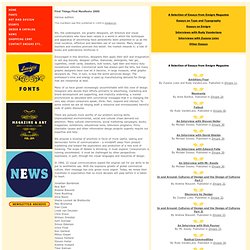

Essays. First Things First Manifesto 2000 Various authors This manifesto was first published in 1999 in Emigre 51.

We, the undersigned, are graphic designers, art directors and visual communicators who have been raised in a world in which the techniques and apparatus of advertising have persistently been presented to us as the most lucrative, effective and desirable use of our talents. Many design teachers and mentors promote this belief; the market rewards it; a tide of books and publications reinforces it. Encouraged in this direction, designers then apply their skill and imagination to sell dog biscuits, designer coffee, diamonds, detergents, hair gel, cigarettes, credit cards, sneakers, butt toners, light beer and heavy-duty recreational vehicles. Manifesto. A manifesto is a published verbal declaration of the intentions, motives, or views of the issuer, be it an individual, group, political party or government.[1][2][3][4] A manifesto usually accepts a previously published opinion or public consensus and/or promotes a new idea with prescriptive notions for carrying out changes the author believes should be made.

It often is political or artistic in nature, but may present an individual's life stance. Manifestos relating to religious belief are generally referred to as creeds. Etymology[edit] Manifesto is derived from the Italian word manifesto, itself derived from the Latin manifestum, meaning clear or conspicuous.
Its first recorded use in English is from 1620, in Nathaniel Brent's translation of Paolo Sarpi's History of the Council of Trent: "To this citation he made answer by a Manifesto" (p. 102). Manifesto for Agile Software Development. Act for culture in Europe.